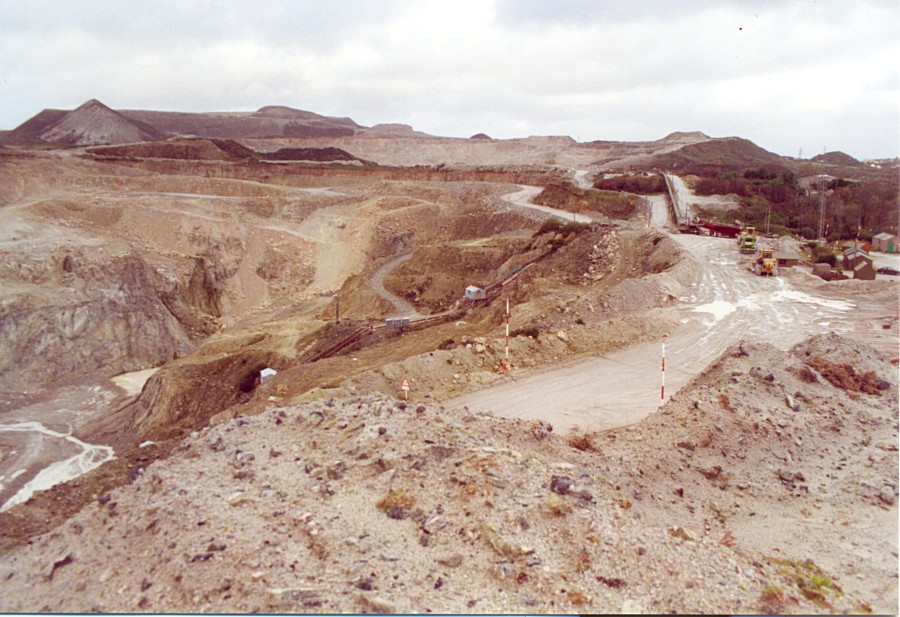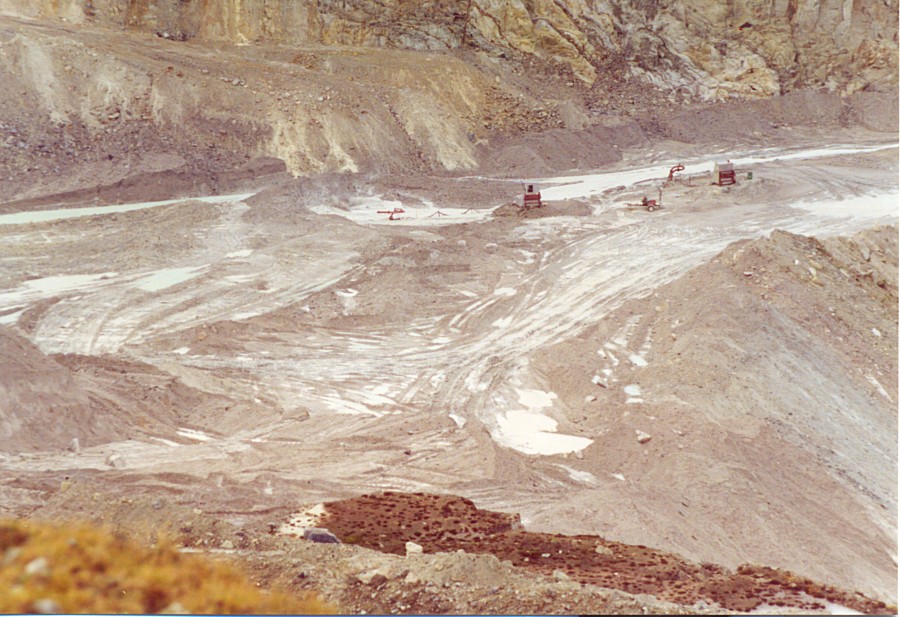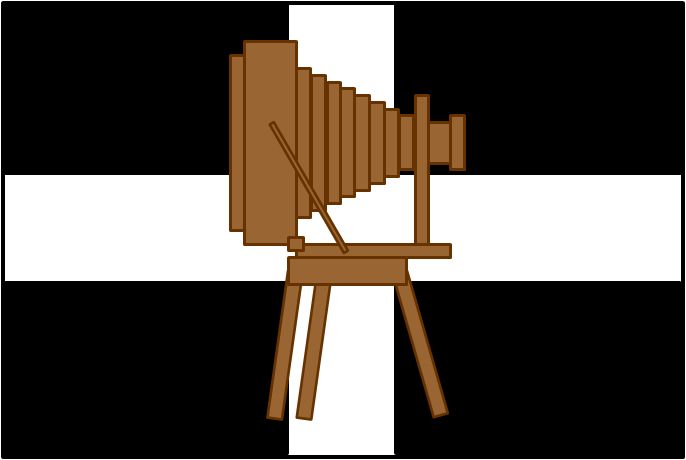Photographs taken 2010 and earlier
The "Cornish Alps" is the name given to an area of mid-Cornwall that has literally grown up out of the ground and enmeshed itself with the natural uplands of the Hensbarrow area. Added to these granite uplands, the china clay quarries have generated massive spoil heaps, often referred to as "sky tips", that together with the white china clay has created an almost alpine look to the area. Some sky tips have taken on a distinct pyramid look, while other spoil heaps have added to the natural lay of the land, and expanded the contours of natural features. These natural and man-made "mountains" have become known locally and beyond, as the Cornish Alps.

The Cornish Alps from a distance after a January snow flurry -
accentuates the alpine scene!
China Clay is essentially decomposed granite. The part of this decomposition that is referred to as China Clay, is the Kaolin from the changed feldspar crystals within the granite. Kaolin is a white clay-like substance that has been used to make porcelain, or "china", as the porcelain imported from China became commonly known as. "China" made elsewhere, such as from kaolin in the UK, is known as "porcelain". That is the essential difference between the two. Kaolin has had many uses, not only for use in manufacturing porcelain, but also in manufacturing paper and other commodoties. The modern Cornish China Clay industry was founded by William Cookworthy, who prospected for and found the huge reserves of china clay in Cornwall during the late 1740s. Control and exploitation of the clay deposits over the next 30 years passed to the potters of Staffordshire, and the clay pits (or "Setts") expanded to fill the demand, but control of the pits was soon back with Cornwall, and the industry thrived.

Looking back at Goonbarrow china clay spoil tip

Goonbarrow spoil tip from Roche Rock
The extent of China Clay Country is evident when viewed on Google Maps, as is the reason for which the "Cornish Alps" have gained their nick-name. It is a region apart from the rest of Cornwall, yet a region very important to the economy of Cornwall, and a continuation of the county's much greater industrial past. It is an area, if you get the chance, to visit and see the modern clay industry at work, and is a fascinating insight for it. To see how the industry has evolved in Cornwall over the past 250 years, and its importance, you can visit the Wheal Martin China Clay Museum near Carthew.

The "Cornish Alps" China Clay Area in mid-Cornwall - roughly to the
NW of St Austell - Goonbarrow is just
to the left
of Bugle, top right of image. (courtesy of Google
Earth - click image to open in Google Maps)
One of the old sky tips that still retains its pyramidal look is the "Carluddon Pyramid", together with what, from a distance, could be taken as a snow-capped peak. Truly a miniature "alp" in its own right! The number of working pits has declined over the years, but those that have survived have grown into much larger operations, many coming together under the English China Clays company, that was eventually to become a wholly owned subsidiary of the French company Imetal, and is now known as Imerys, operating in Cornwall as Imerys Minerals Ltd.

Carluddon Pyramid
China Clay Pit at Wheal Martyn in the early 1990s
The following photographs were taken on a trip to the Wheal Martyn China Clay Museum in 1991, from the viewpoint at the top of the museum outdoor area that looks out over a working clay pit. Together with old engine houses that would have been used to pump out the clay slurry, it was possible to see the water "monitors" that were used to wash out the clay from the pit, thus creating the slurry to transport the kaolin clay for drying.

Old Pump Engine House and mini-sky tip for waste material at Wheal
Martyn

Extensive clay workings

A landscape transformed

Looking down into the clay pit to where a water monitor lies dormant

The water monitors are operated remotely and are used to extract the
kaolin from the pit, to be pumped away as slurry.
Other China Clay Pits
Courtesy of Google Earth, it is possible to explore some of the other extensive clay pits in the area, as viewed from above. Not a regular feature of this PhotoFile website, but it is a useful facility to gain a sense of how extensive the current Cornish Alps and "Clay Country" really are.

Looking north over the Wheal Martyn Clay Pit and associated works
near Carthew

Looking north-west over the old Blackpool China Clay Works over
Watch Hill towards Foxhole

Looking north over the extensive works north of Longstone Downs (at
the very bottom of the image)
For further information on China Clay, and the uses of Kaolin, see the Imerys-Kaolin website.


Connect with us, Like us and Follow us on Facebook!
PhotoFile Cornwall supports CoaST and Sustainable Tourism